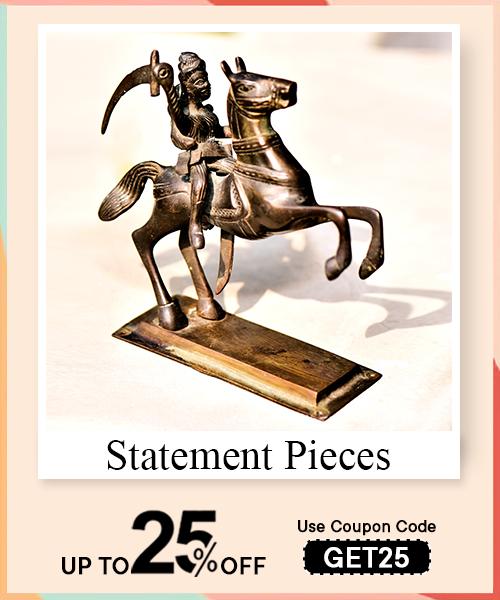Thangka paintings are unique paintings without frames. And the only way to keep them when not hung up or not kept on display is by rolling them. Thangkas are delicate paintings, but they can last very long if treated right. They should be kept in dry places where moisture cannot affect the silk or cotton fabric of the painting.
If you observe, you will find that most traditional Thangka paintings are more miniature when compared to a Western half-length portrait, but you will also find that some paintings are large, several meters in each direction. Most thangkas were intended for personal meditation or instruction of monastic students. They often have elaborate compositions, including many tiny figures. A central deity is surrounded by other identified figures in a symmetrical design. Thangka art is an important teaching tool depicting Lord Buddha's life, various influential lamas, and other deities and bodhisattvas. One subject is the Wheel of Life (Bhavachakra), a visual representation of the Abhidharma teachings, the Art of Enlightenment.
Read More - THE ULTIMATE GUIDE TO CARING FOR YOUR PAINTINGS
The widespread traditions of early Buddhist paintings inspired Tibetan Buddhist paintings. They show the rich cultural heritage of Buddhism. The early Buddhist paintings can now only be seen at the Ajanta caves in India and the Mogao caves in China because only these paintings survived out of many. The thanka form developed alongside the tradition of Tibetan Buddhist wall paintings, which are or were mostly in monasteries.
The early history of traditional Buddhist paintings is more easily traced through these murals as they survived easily in great numbers rather than the paintings, which only existed once. Most Thangka paintings were commissioned by individuals believed to acquire merit by doing so. They might then be given to a monastery or another individual or retained by the commissioner. Some thangka have inscriptions on their backs recording that they were the personal meditation image of a notable monk. Most artists were monks, although some lay artists also existed, as they did work for metal sculpture. The commissioner would provide the materials, which were often valuable, and by tradition, the compensation to the artist was regarded as a "gift" rather than a “fee.” One of the earliest specimens of Nepalese Thangka painting dates from the thirteenth /fourteenth century and shows Amitabha surrounded by bodhisattva. Another Nepalese thangka with three dates in the inscription (the last one corresponding to 1369 A.D.) is one of the earliest known thangka with reminders. The "Mandala of Vishnu," dated 1420 A.D., is another fine example of the painting of this period. Early Nepalese Tangkas are simple in design and composition. The main deity, a prominent figure, occupies the central position, surrounded by more miniature figures of lesser divinities.
In Classical Tibetan, the word “Thangka” implies a thing that one unrolls. The earliest surviving Tibetan paintings on cloth are from the Mogao Caves at Dunhuang on the Silk Road in Gansu province, China. Many paintings have Tibetan inscriptions or are in a style that can be recognized as Tibetan, and some pieces reflect Indian styles. Tibetan painting included many elements from Han Chinese painting, especially from the 14th century onwards, which peaked in the 18th century. One difference was the allowance of more space and emphasis on the landscape background. Generally, the style of figures in Thangka paintings remains derived from the Indo-Nepalese tradition.
Tangka paintings were painted in all the areas where Tibetan Buddhism flourished. These places include Mongolia, Sikkim, Ladakh, and Himalayan parts of India in Arunachal Pradesh, Dharamshala, Lahaul, and Spiti in Himachal Pradesh.
Read More - PICHWAI PAINTING FOR BEGINNERS
Thangka paintings are painted on fabric like cotton or silk. The paints used in the process consist of pigments in a water-soluble medium of animal glue. Both mineral and organic dyes are used.
In Nepal, 24-carat gold is also plated over some parts of Thangka paintings, which makes the Thangka paintings a little more expensive.
As with most Buddhist art, a thangka's composition is highly geometric. Arms, legs, eyes, nostrils, ears, and various ritual implements are all laid out on a systematic grid of angles and intersecting lines. A skilled thangka artist will generally select from different predesigned items to include in the composition, ranging from alms, bowls, and animals to the shape, size, and angle of a figure's eyes, nose, and lips. The process looks methodical but often requires a deep understanding of the symbolism involved to capture the spirit of it.
Thangka often overflows with symbolism and allusion. Because the art is explicitly religious, all symbols and allusions must follow strict guidelines in Buddhist scripture. The artist must be adequately trained and have sufficient spiritual understanding, knowledge, and background to create an accurate and appropriate Thangka painting.
Some key religious Buddhist symbolism in Thangkas are lotus flowers, banners, knots, fish, umbrellas, vases, conch shells, and the dharma wheel. These motifs are referred to as the eight auspicious symbols in Tibetan Buddhism.
The lotus flower, usually pink or light red, symbolizes enlightenment and spiritual purity as the flower emerges from the mud. The lotus flower is generally seen with 8 or 16 petals and can have different colors to represent other motifs. For example, the white lotus is specific to Buddha Sikhin, but lotuses can also appear in yellow or gold.
The victory banner, which usually appears as a four-coloured cylindrical design with a central pole, represents the triumph of Buddha over ignorance. Similarly, a white parasol or umbrella represents the ability of Buddha to triumph over everything, and a conch shell also represents victory over enemies.
The knot, also known as the “endless knot” or “glorious knot,” represents longevity and harmony. When fish appear in thangka paintings, they are usually seen in pairs, symbolizing the unity and peace that arrives as a person approaches enlightenment. The treasure vase, usually gold and never dry, represents abundance.

The final symbol of the thangka is the dharma wheel. The dharma wheel has three components: rim, hub, and spokes. These three pieces represent integrity, wisdom, and attentiveness. The dharma wheel also always features eight spokes representing the eightfold Noble Path towards enlightenment. The wheel can also often be embellished with jewels, ribbons, and sometimes a lotus base.
Read More - HOW IS PICHWAI MADE?
Historically, Tibetan and Chinese influence in Nepalese paintings is quite evident in Thangkas, and Nepalese styles have significantly influenced Tibetan art. Thangkas are of two types: the Palas, which are illustrative paintings of the deities, and the Mandala, which are mystic diagrams paintings of complex test prescribed patterns of circles and squares, each having specific significance.
Dr. Sarika Singh is the first Indian female painter and teacher in the Buddhist tradition of Thangka Painting. Born on 13 August 1976 in New Delhi, she began her studies in the art of Thangka painting in 1996 at the prestigious Norbulingka Institute in Dharamshala, Northern India, under the tutelage of her master, Tempa Choephel. In the year 2015, she completed her Master’s degree in ‘Buddhist and Tibetan Studies’ from Punjab University and ‘Ph.D.’ from Central University of Himachal Pradesh in the year 2021.
Along with her husband, Master Locho, one of the finest Master Thangka painters in the world, Singh co-founded the ‘Center for Living Buddhist Art’ and 'Thangde Gatsal Thangka Studio' in 2001. In 2019, they established the Himalayan Art Museum, which connects us to the rich cultural heritage of India and Tibet.
Khandu Wangchuk Bhutia is another Sikkim State of India artist known for his exquisite creative works in the Thangka painting style. Thangka is a Tibetan Buddhist painting on cotton, silk appliqué, usually depicting a Buddhist deity, scene, or mandala. Khandu Wangchuk Bhutia hailed from Sakyong in West Sikkim and had formal education at Government Senior Secondary School in Pelling and Senior Secondary School at Namchi. After his formal education, he was ordained into monastic life at the Pemayangtse Monastery. In the monastery, he took up Thangka painting as a profession. He trained in Thangka painting under several renowned thangka painters like Dungzin Rimpoche, the late Jigme Wangchuk Lama, the late Phuntsok Sangpo, and the late Zapa Acho.
In 2022, Govt. of India conferred the Padma Shri award, the third highest award in the Padma series of awards, on Khandu Wangchuk Bhutia for his distinguished service in art. The award recognizes his service as an "Eminent Thangka painter from Sikkim specializing in traditional Buddhist paintings on cotton and silk."
Tseten Dorjee was born on 2 December 1960 in Darjeeling and lived in India to receive his early education at the Central School for Tibetans in Darjeeling, India. Dorjee started studying thangka painting between 1974 and 1980 when he took private lessons from the late Venerable Ngawang Norbu (1903–1996). He continued his studies from 1980 to 1986 at the Gyudmed Tantric Monastery in Mysore, South India. Dorjee received commissions from the 14th Dalai Lama, the Royal Family of Sikkim, and various significant monasteries in India. Dorjee traveled and painted thangkas outside of India in Bhutan, Nepal, Munich, and the USA. Dorjee started teaching thangka painting in 1995. Over the years, 11 students became accomplished thangka painters after four to five years under his guidance. As of 2011, he was instructing six full-time students. Dorjee became a faculty member of Naropa University's Study Abroad Program in Sikkim in the fall of 2002.
Thangkas are scroll paintings that are vertical in format, usually in a size that is rolled up, often about half to one and a half meters high. However, giant thangkas for special ceremonies can require dozens of people to unroll and display them. Like religious wall paintings, thangkas are considered to function as intermediaries between the mortal and divine worlds. The thangka started as a traditional Nepalese art form.
The thangka is devised to be conveniently rolled for transportation, which is a source of physical and mechanical damage. Rolling compresses and abrades the surface, and abrasion is aggravated when the cover is missing. Moving it with all its different components is difficult, even if distorted. Moreover, the various features of the thangka rarely have the exact composition or thickness. Consequently, when rolled, the pressure is unequal on all the parts, resulting in folds and creases. These folds and creases are destructive because they form areas of weakness. Giant thangkas are at higher risk of such damage.
The following are preventive measures for the care of Thangkas:
- Use two thick ribbons, slightly shorter than the thangka, and stitch to the ends of both rods on the reverse side of the thangka to prevent the lower rod from straining the thangka.
- The rolling of the thangka is to be done on a flat surface and not in a hanging position to minimize creasing, rolling carefully but firmly on the lower rod.
- The practice of display rotation, as opposed to permanent displays, to achieve long-term preservation. This has been justified because it is usual practice in temples or monasteries to put the thangka on only on special occasions, which preserves it.
- Use showcases to prevent the accumulation of dirt.
- Use appropriate lighting and light levels.
- The provision of handling instructions, condition checklist, and display recommendations such as restrictions on traditional sprinkling of water to minimize the problems.
- Use of inert materials for storage and display.
The price of Thangka varies from one another. It is not the size of Thangka that alters the pricing but the amount of detail presented in the painting. Hand-painting Thangka takes a couple of months to more than a year to complete, working about 7 hours daily. Thangka paintings are valued and worth much more than you could imagine. Each Thangka painting is worth preserving and caring for because it has religious references and is also worth an expensive and leisurely account.
Read More - THE ROLE OF EMOTION IN ABSTRACT ART
Thangka paintings represent the true cultural heritage of India. Thangka paintings are authentic Tibetan paintings made of cotton or silk fabric. They are costly paintings. Thanka painting's lining and measurement, costumes, implementations, and ornaments are primarily based on Indian styles. The drawing of figures is based on the Nepalese style, and the background sceneries are based on the Chinese style. Thus, the thangka paintings are a unique and distinctive art. Tangka paintings are painted in all the areas where Tibetan Buddhism flourished. They are well renowned and famous in Arunachal Pradesh and the Himalayan region in India. Thangka painting has developed in the northern Himalayan regions among the Lamas. It is necessary to clean and maintain your Thangka paintings properly. Most soot and oil stains penetrate deep into the silk/cotton mounting and the paintings, and removing these stains without damaging the original thangka/painting is tricky. It is therefore advised not to clean these at home and to consult a conservator.
Thangka paintings are precious and worth millions. You can use them to decorate your homes while being inspired by the religious heritage and bathing in the divine blessings. Cherish the most famous art of India, the Thangka paintings, by taking a glimpse of some of the most famous images on the website of IndianShelf.















